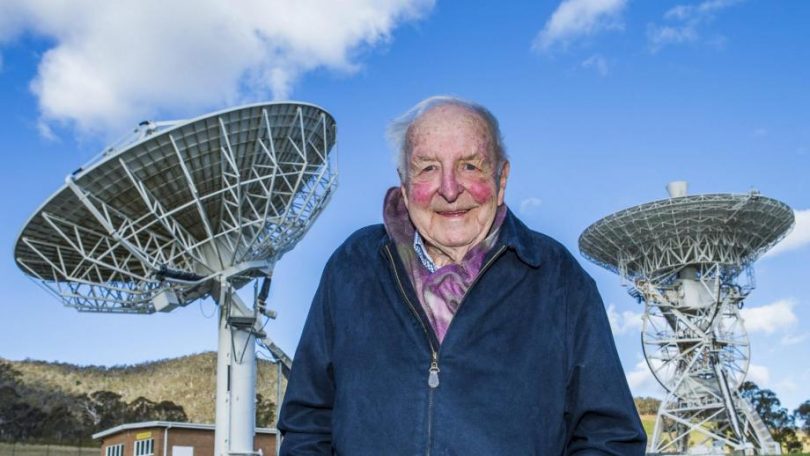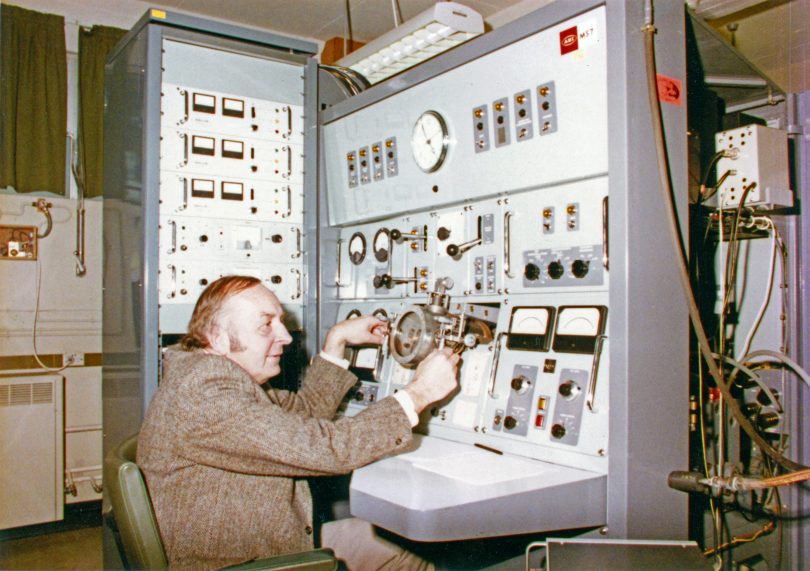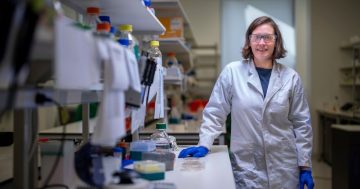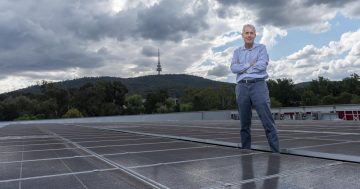
Professor Stuart ‘Ross’ Taylor at the Canberra Deep Space Communication Complex. Photo: Stuart Hay.
During his 95 years on Earth, Professor Stuart ‘Ross’ Taylor was fascinated by the moon. With his death this week, the Canberran has been credited as a pioneer of lunar science.
His work in carrying out initial chemical analyses of lunar samples brought back to Earth by Apollo 11 in 1969 and Apollo 12 in 1970 led to his interest in the origins and evolution of the solar system.
He once said, “I have kept one foot on the Earth and one on the moon.”
Born in New Zealand in 1925, the budding scientist overcame a burst appendix at age 10. In an interview with Professor Bob Crompton in 2000, he credited the doctor “who saved me from another place”.
A strong interest in chemistry at high school led to his formal qualifications as a Bachelor of Science and then Master of Science. In 1954, he received a PhD from Indiana University, in the US, before teaching at Oxford University, in the UK, and then the University of Cape Town in South Africa as a senior lecturer in geochemistry.
In 1961, he moved to the Australian National University as a senior fellow in geophysics and was soon appointed as a fellow at ANU’s Research School of Earth Sciences.
But it was Professor Taylor’s work with lunar samples that led to him being ‘lost in space’.

Professor Taylor with the spark source mass spectrometer at ANU in May 1994. Photo: Hamish Lindsay.
When Neil Armstrong took those first steps onto the moon in 1969, Professor Taylor was watching the broadcast with particular interest.
He had set up a laboratory at the ANU eight years earlier that was almost identical to the one used by the initial group assembled in Houston. It led the NASA scientific director to ask Professor Taylor to run the lab and carry out the first spectrographic analysis of moon rock.
Professor Taylor had already begun building a home in Canberra, but the offer was too good to refuse so his wife, Noël, also a scientist, said he should stay on in the US.
“So I settled down with about three months to prepare for the lunar samples, and when I did come home she had finished the house,” he said.
Professor Taylor quickly built his reputation by analysing the first rock samples from the moon, and 70 different elements from the spectral lines they produce.
“But those 70 elements could produce 100,000 possible lines,” he once said.
He nearly missed one of the most significant traits of the moon’s chemistry in its significantly lower sodium levels than Earth, but managed to rectify the oversight before the scheduled press conference.
He would also ignore the turning of the day into night to work on his love of lunar science so he could deliver results to daily 4:00 pm press conferences.
Professor Taylor also had an insight into what the world is now facing with the COVID-19 pandemic, telling how samples from the Apollo program had to be opened in a sealed glovebox to protect the world from infection by hypothetical lunar microbes.
“One of the gloves in the box tore while Ross [a colleague] was working near it, theoretically exposing everyone in the room to deadly lunar pathogens,” he once said. “Protocol was that everyone exposed to lunar germs had to be put into quarantine for two weeks.
“The astronauts’ clothes were coated with it; the inside of the capsule was coated with it; and as they opened the capsule, the whole Pacific Ocean was exposed to lunar soil. At that point, the quarantine had already gone. What we were putting up with was, effectively, a public relations exercise, as was widely understood in the laboratory.”
Professor Taylor’s scientific achievements are published in more than 200 papers and in seven books, some after his retirement in 1990.
The international recognition of his work includes a doctorate in science from Oxford University; election as a Foreign Associate of the US National Academy of Sciences, in 1994; and a Companion of the Order of Australia in 2008.
Additionally, above our heads circles an asteroid named in his honour: 5670 Rosstaylor.
At the turn of the century, Professor Taylor said his career had been fascinating by proving the moon was, in fact, not a piece of cheese.
“It’s interesting to think of the areas you find yourself working on,” he said. “Just being led from one area into the next, just following your nose, you can finish up in the middle of the solar system.”















